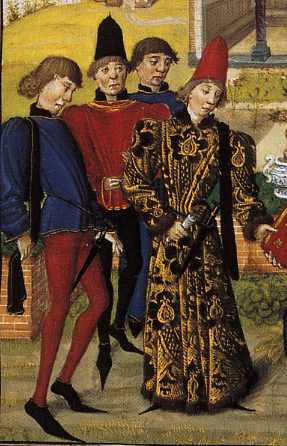|
Pigache
Pigache, Poulaine and Pigage are types of shoe with a long pointed turned up toe that was worn during the Romanesque and Byzantine period. The plural form of the word is pigaciae. The shoes were sometimes stuffed with moss, wool, or horsehair to make the extension erect. The protrusion was sometimes flesh colored. In the 12th century the shoes had a pointed and hooked toe that was sometimes adorned with a small bell. Marie-Josèphe Bossan - 2012 Page 266 See also *Crakow
Crakows or crackowes were a style of shoes with extremely long toes very popular 1400–1500 in European fashion, in 15th century Europe. They were so named because the style was thought to have originated ...
[...More Info...] [...Related Items...] OR: [Wikipedia] [Google] [Baidu] |
Crakow
Crakows or crackowes were a style of shoes with extremely long toes very popular 1400–1500 in European fashion, in 15th century Europe. They were so named because the style was thought to have originated in Kraków, the then capital of Poland. They are also known as poulaines or pikes, though the term ''poulaine'', as in ''souliers à la poulaine'', "shoes in the Polish fashion", referred to the long pointed beak of the shoe, not the shoe itself. History Long-toed shoes had been popular in Europe at different times, first appearing in the archaeological record in the 12th century and falling in and out of fashion periodically. They reached their most exaggerated form in the third quarter of the 15th century before falling out of fashion in the 1480s. The arrival of this fashion in England is traditionally associated with the marriage of Richard II and Anne of Bohemia in 1382. An anonymous 'monk of Evesham' recorded in 1394: "With this queen there came from Bohemia into Englan ... [...More Info...] [...Related Items...] OR: [Wikipedia] [Google] [Baidu] |
Historical Footwear
History (derived ) is the systematic study and the documentation of the human activity. The time period of event before the invention of writing systems is considered prehistory. "History" is an umbrella term comprising past events as well as the memory, discovery, collection, organization, presentation, and interpretation of these events. Historians seek knowledge of the past using historical sources such as written documents, oral accounts, art and material artifacts, and ecological markers. History is not complete and still has debatable mysteries. History is also an academic discipline which uses narrative to describe, examine, question, and analyze past events, and investigate their patterns of cause and effect. Historians often debate which narrative best explains an event, as well as the significance of different causes and effects. Historians also debate the nature of history as an end in itself, as well as its usefulness to give perspective on the problems of the p ... [...More Info...] [...Related Items...] OR: [Wikipedia] [Google] [Baidu] |
Byzantine Clothing
Byzantine dress changed considerably over the thousand years of the Empire, but was essentially conservative. Popularly, Byzantine dress remained attached to its classical Greek roots with most changes and different styles being evidenced in the upper strata of Byzantine society always with a touch of the Hellenic environment. The Byzantines liked colour and pattern, and made and exported very richly patterned cloth, especially Byzantine silk, woven and embroidered for the upper classes, and resist-dyed and printed for the lower. A different border or trimming round the edges was very common, and many single stripes down the body or around the upper arm are seen, often denoting class or rank. Taste for the middle and upper classes followed the latest fashions at the Imperial Court. As in the West during the Middle Ages, clothing was very expensive for the poor, who probably wore the same well-worn clothes nearly all the time;Payne, Blanche; Winakor, Geitel; Farrell-Beck Jane: ' ... [...More Info...] [...Related Items...] OR: [Wikipedia] [Google] [Baidu] |

.jpg)
